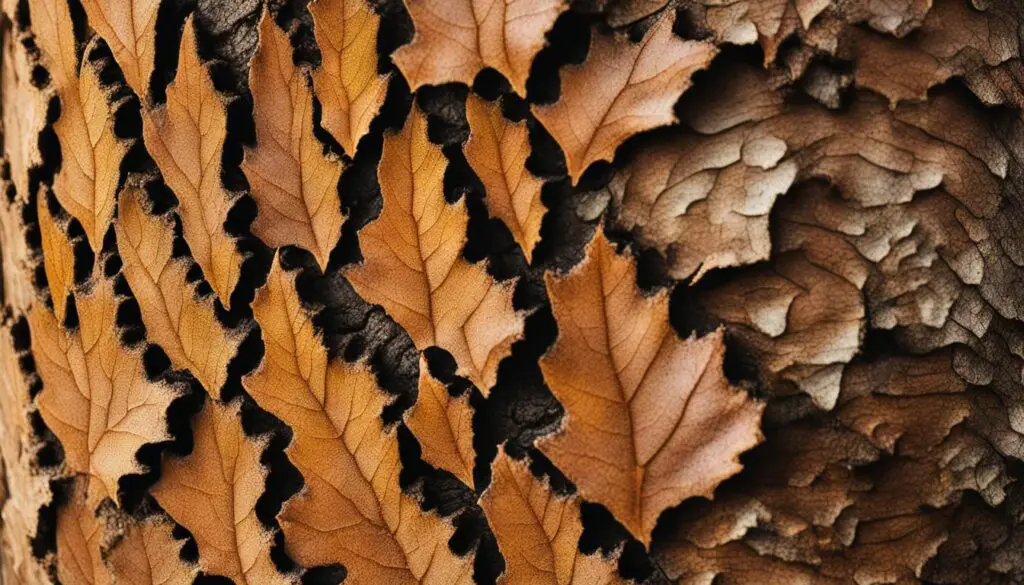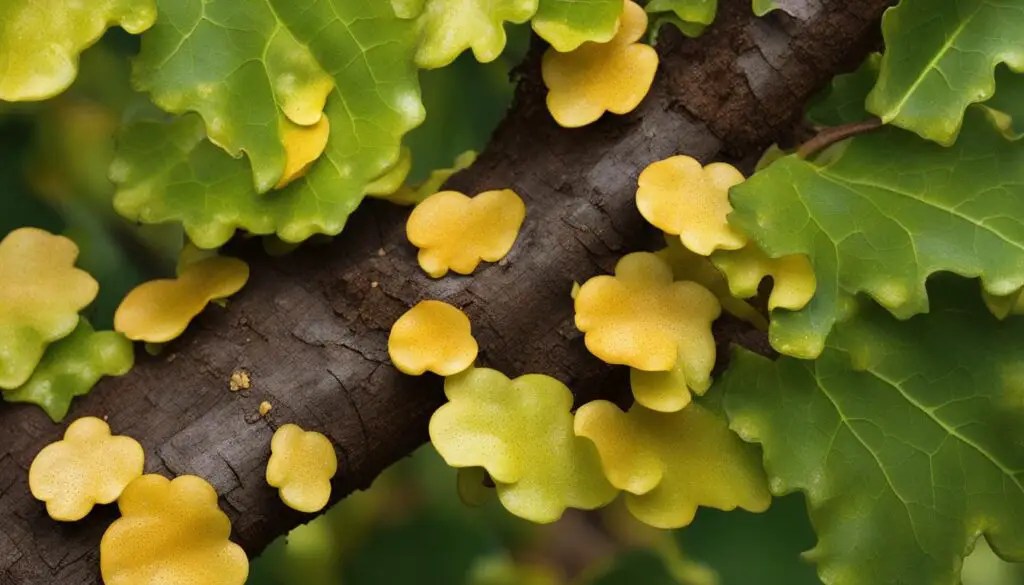Oak trees are a beloved and iconic tree species known for their strength, beauty, and longevity. Have you ever wondered where these magnificent trees thrive and grow? In this article, we will explore the diverse habitats where oak trees can be found, their distribution across the globe, and the importance of oak tree habitats.
From ancient forests to urban landscapes, oak trees have adapted to various environments, making them a versatile and resilient species. Let’s delve into the fascinating world of oak tree habitats and discover where these majestic trees call home.
- Oak trees are native to diverse habitats around the world.
- They can be found in forests, woodlands, and even urban areas.
- The distribution of oak trees spans five continents, with a significant number of species in North America.
- Oak trees play a vital role in supporting wildlife and contributing to clean air quality.
- Oak trees are highly adaptable and can thrive in a range of soil types and sunlight conditions.
Native Range of Oak Trees in the UK
In the United Kingdom, oak trees are abundant and play a vital role in supporting biodiversity. The country is home to two native oak tree species: the English oak (Quercus robur) and the sessile oak (Quercus petraea). These majestic trees are found throughout the UK and contribute significantly to the country’s natural heritage.
Oak trees in the UK provide critical habitats for a diverse range of wildlife species. Insects, birds, and mammals rely on these trees for food, shelter, and nesting sites. The native range of oak trees in the UK extends from lowland areas to upland forests, allowing them to thrive in various environments.
The biodiversity supported by oak trees in the UK is remarkable. They create an intricate web of life, hosting a myriad of organisms and contributing to the overall health of ecosystems. These trees are not just beautiful and majestic sights in the British landscape; they are critical components of the natural world.
By preserving and protecting the native range of oak trees in the UK, we ensure the continuity of biodiversity and the conservation of these valuable habitats for future generations.
Oak Trees in North America: Dominant Forest Species
Oak trees are highly prevalent in North America, accounting for a significant portion of forest tree biomass. With approximately 60% of all Quercus species found on the continent, they are considered the most important group of trees in North America’s forests. These majestic trees have a wide distribution, ranging from Canada to Mexico and from the eastern coast to the western region.
North American oak trees are dominant species in various ecosystems, including temperate deciduous forests and oak savannas. Their ability to adapt and thrive in diverse environmental conditions has made them a vital component of the continent’s natural landscapes and biodiversity.

The distribution of oak trees in North America is a testament to their resilience and adaptability. They can be found in different regions, from the Great Lakes and Appalachian Mountains to the coastal plains and deserts of the southwestern United States. This wide distribution is a result of their ability to tolerate a range of soil conditions and climates, from moist and fertile to dry and arid.
North American oak trees play a crucial role in supporting wildlife habitats and providing food and shelter for numerous species, including birds, mammals, and insects. They are also valued for their economic and cultural uses, with oak wood being highly sought after for furniture, flooring, and construction.
In addition to their ecological and economic importance, North American oak trees contribute to the aesthetic beauty of the landscape, especially during the fall season when their leaves turn vibrant shades of red, orange, and yellow.
Evolution and Diversification of Oak Trees
Oak trees have a fascinating evolutionary history that spans over 56 million years. From a single population, they have diversely evolved into approximately 435 species found worldwide. Recent advancements in oak tree genome sequencing have shed light on their origin, diversification, and dispersal. This valuable insight has enabled researchers to better understand the evolutionary success of oak trees and their ability to adapt and thrive in various environmental conditions.
The evolution of oak trees has played a vital role in shaping ecosystems and human culture. These trees have contributed significantly to biodiversity, providing habitats for numerous wildlife species. Oak trees also play a crucial role in carbon sequestration, helping to mitigate climate change. Additionally, they have been a valuable resource for humans for centuries, providing timber for construction, fuel, and even food in the form of acorns.
Genome sequencing has revolutionized our understanding of oak trees, revealing intricate details about their genetic makeup. The analysis of the oak tree genome has provided valuable information on the mechanisms behind their adaptability, disease resistance, and other important traits.
By studying oak tree evolution and diversification, researchers gain insights into how these magnificent trees have thrived and adapted over millions of years. This knowledge can inform conservation efforts and help us better protect and preserve oak tree species for future generations.
Oak Tree Habitat Requirements and Growth Characteristics
Oak trees are highly adaptable and can thrive in various habitats, including forests, woodlands, and even urban areas. These majestic trees have specific habitat requirements and unique growth characteristics that contribute to their longevity and environmental significance.
Habitat Requirements:
When it comes to habitat requirements, oak trees are remarkable in their adaptability. They can tolerate a wide range of soil types, from acidic to alkaline, and are found in diverse locations worldwide.
Here are the key habitat requirements for oak trees:
- Soil Type: Oak trees can grow in various soil types, including sandy, loamy, and clay soils. They are also known to thrive in both acidic and alkaline soil conditions.
- Sunlight: Oak trees prefer full sun or partial shade for optimal growth and development. They require sufficient sunlight to produce energy through photosynthesis.
- Watering: During establishment, oak trees require regular watering to ensure proper root development and overall health. Once established, they can tolerate periods of drought.
Growth Characteristics:
Oak trees exhibit remarkable growth characteristics that contribute to their impressive stature and longevity. Depending on the species and environmental factors, oak trees can live anywhere from 100 to 300 years.
Here are the key growth characteristics of oak trees:
- Height and Spread: Oak trees are considered fast-growing and can reach impressive heights of 40 to 80 feet with a spread of 60 to 100 feet. Their expansive canopies provide shade and habitat for numerous wildlife species.
- Lifespan: Oak trees have an impressive lifespan, ranging from 100 to 300 years. The lifespan may vary depending on the species and environmental factors, but oak trees are known for their longevity, making them valuable components of ecosystems.
With their adaptability, oak trees make a significant contribution to biodiversity and ecological balance. They provide essential habitat for wildlife and play a crucial role in carbon sequestration, clean air production, and soil stabilization.

Oak Tree Habitat Requirements and Growth Characteristics
| Habitat Requirements | Growth Characteristics |
|---|---|
| Soil Type: Adaptable to various soil types, including acidic and alkaline soils. | Height and Spread: Fast-growing, reaching heights of 40 to 80 feet with a spread of 60 to 100 feet. |
| Sunlight: Prefers full sun or partial shade for optimal growth. | Lifespan: Impressive lifespan of 100 to 300 years, depending on the species and environmental factors. |
| Watering: Requires regular watering during establishment, tolerant of drought conditions once established. |
Pruning and Care for Oak Trees
Proper pruning and care are essential for maintaining the health and longevity of oak trees. By following the right techniques and implementing effective care practices, you can ensure that your oak trees remain vibrant and beautiful.
One of the key aspects of oak tree care is pruning. Pruning should be done during the winter months when the tree is dormant. This helps in shaping the tree’s crown and removing any low-growing or weak branches. By carefully selecting the branches to prune, you can improve the overall structure and aesthetics of the tree.
When pruning oak trees, it is crucial to make cuts outside the branch collar. The branch collar is the swollen area where the branch connects to the trunk. By avoiding cuts too close to the trunk, you prevent damage to the vital tissues and minimize the risk of disease or decay.
In addition to pruning, regular watering is essential for the health of oak trees, especially during dry periods. Water the tree deeply, allowing the water to penetrate the soil and reach the tree’s roots. This helps in keeping the tree hydrated and ensures its overall well-being.
Disease prevention is another crucial aspect of oak tree care. By maintaining good tree care practices, you can reduce the risk of common oak tree diseases such as oak leaf blister and bacterial leaf scorch. These diseases can cause significant damage to the tree’s foliage and overall health.
Here are some key practices to prevent oak tree diseases:
- Regularly inspect the tree for any signs of disease, such as leaf discoloration or abnormal growth.
- Remove any infected branches or leaves promptly to prevent the spread of disease.
- Ensure the tree has proper airflow and sunlight to minimize moisture buildup and create unfavorable conditions for disease development.
- Implement proper irrigation practices to avoid overwatering, which can create a conducive environment for disease.
- Consult a professional arborist or tree care specialist for guidance on specific oak tree diseases and preventive measures.
By incorporating pruning and proper care practices into your oak tree maintenance routine, you can promote their health, enhance their appearance, and protect them from common diseases. A well-cared-for oak tree can provide shade, beauty, and numerous benefits for many years to come.
Common Oak Tree Diseases
Oak trees are prone to several diseases that can impact their health and vitality. Two common diseases that affect oak trees are oak leaf blister and bacterial leaf scorch.
Oak leaf blister is characterized by the appearance of blister-like patches on the leaves. These blisters can be up to half an inch in diameter and are often surrounded by a red or pink halo. As the disease progresses, the affected leaves may turn yellow or brown and eventually fall off. Oak leaf blister is caused by the fungal pathogen Taphrina caerulescens, which infects the tender spring leaves of oak trees.
Bacterial leaf scorch is another common disease that affects oak trees. It is caused by the bacteria Xylella fastidiosa and manifests as gradual leaf discoloration, starting from the tips and edges of leaves. Infected leaves may show marginal scorching, turning brown or reddish-brown, and eventually, drop prematurely. The bacteria spread through the xylem vessels of the tree, disrupting water and nutrient transport.
To prevent and manage these diseases, proper care and maintenance of oak trees are crucial. Here are some recommended practices:
- Regular watering: Providing adequate water to oak trees helps maintain their overall health and resilience. Water deeply and infrequently, ensuring the soil is moist but not waterlogged.
- Pruning and removal of infected branches: Prune dead or diseased branches, and promptly remove any infected material from the tree and the surrounding area. This helps prevent the spread of diseases and minimizes the risk of reinfection.
- Avoid over-fertilization: Excessive fertilization can stress oak trees, making them more susceptible to diseases. Follow the recommended fertilization guidelines for your specific tree species and consult a professional if needed.
- Monitoring for signs of disease: Regularly inspect oak trees for any signs of disease, such as blister-like patches on the leaves or leaf discoloration. Early detection allows for prompt intervention and better chances of managing the diseases effectively.
- Consultation with an arborist: If you are unsure about the health of your oak trees or need guidance on disease prevention and management, it is advisable to seek the expertise of a certified arborist.
By implementing these practices, you can protect the health and vitality of your oak trees and ensure their longevity in your landscape.

Oak Tree Insect Pests
When it comes to oak trees, insect pests pose a significant threat to their health and vitality. Several types of pests can infest oak trees, including galls, scale insects, and oakworms. Understanding these pests and implementing appropriate pest control measures is crucial for protecting the beauty and longevity of your oak trees.
Galls: Abnormal Growth Caused by Insects
Galls are abnormal growths on oak trees, typically caused by insects or mites. These small creatures induce the formation of galls by injecting chemicals into the tree’s tissues, triggering an abnormal response. Galls can appear on various parts of oak trees, including leaves, twigs, and even acorns. Although galls are generally harmless to the overall health of the tree, they can cause aesthetic concerns for tree owners.
Scale Insects: Immobile Pests That Disrupt Tree Health

Scale insects are a common pest that can infest oak trees. These small, immobile insects often appear as tiny bumps or scales on the stems and leaves of the tree. Scale insects feed on the tree’s sap, weakening its overall health and making it more susceptible to diseases and other stressors. If left untreated, a severe infestation of scale insects can lead to tree decline or even death.
Oakworms: Defoliating Larvae of Moths
Oakworms, the larvae of certain moth species, are voracious eaters that primarily feed on oak tree foliage. These caterpillar-like pests can consume large amounts of leaves, potentially defoliating the tree. Defoliation by oakworms weakens the tree and can have a significant impact on its overall health and appearance. Regular monitoring and prompt treatment is essential to prevent extensive damage caused by oakworm infestations.
Regular monitoring and appropriate pest control measures can help manage these insect pests and protect the health of oak trees. If you notice any signs of pest infestation on your oak trees, consult with a professional arborist or tree care specialist to determine the best course of action. By addressing insect pests promptly and effectively, you can ensure the continued beauty and vitality of your cherished oak trees.
Conclusion
Oak trees are not only beautiful and majestic but also play a vital role in ecosystems and human culture. They provide critical habitat for wildlife, contribute to clean air quality, and have numerous economic and cultural uses. It is crucial to prioritize oak tree care to ensure their health and longevity.
Proper care practices, such as pruning, regular watering, and disease prevention, are essential for maintaining oak tree health. Pruning helps shape the tree’s crown and removes any weak or low-growing branches. Regular watering during establishment and dry periods is necessary to keep the tree hydrated and thriving. Disease prevention measures, such as monitoring for signs of diseases and removing infected branches, can mitigate the risk of common ailments like oak leaf blister and bacterial leaf scorch.
Conservation efforts are also crucial for preserving oak trees for future generations. By understanding the habitats, growth characteristics, and care requirements of oak trees, we can ensure their survival and continued benefits to our environment. These magnificent trees deserve our attention and care to protect their importance and contribute to a sustainable ecosystem.
FAQ
Where do oak trees grow?
Oak trees are native to various regions around the world. They can be found in diverse habitats, including forests, woodlands, and urban areas.
What is the native range of oak trees in the UK?
In the UK, there are two native oak tree species – the English oak (Quercus robur) and the sessile oak (Quercus petraea). These oak trees are widespread throughout the country and are known for their significance in supporting biodiversity.
Where are oak trees predominantly found in North America?
Oak trees are highly prevalent in North America, with approximately 60% of all Quercus species found on the continent. They are considered the most important group of trees in North America’s forests, accounting for a significant portion of forest tree biomass. Oak trees have a wide distribution across the continent, ranging from Canada to Mexico and from the eastern coast to the western region.
What is the evolutionary history of oak trees?
Oak trees have a rich evolutionary history that spans over 56 million years. They have evolved from a single population into approximately 435 species found worldwide. Recent advances in genome sequencing have provided insights into the origin, diversification, and dispersal of oak trees.
What are the habitat requirements and growth characteristics of oak trees?
Oak trees thrive in a range of habitats, including forests, woodlands, and urban areas. They are adaptable to various soil types and can tolerate both acidic and alkaline conditions. Oak trees prefer full sun or partial shade and require regular watering during establishment. They are considered fast-growing and can reach heights of 40 to 80 feet with a spread of 60 to 100 feet. Oak trees have an impressive lifespan, ranging from 100 to 300 years, depending on the species and environmental factors.
How should I prune and care for oak trees?
Proper pruning and care are essential for maintaining the health and longevity of oak trees. Pruning should be done during the winter months to shape the tree’s crown and remove any low-growing or weak branches. It is crucial to make cuts outside the branch collar to avoid damaging the main trunk. Regular watering, especially during dry periods, is necessary to keep the tree hydrated and healthy.
What are some common oak tree diseases?
Oak trees are susceptible to various diseases, including oak leaf blister and bacterial leaf scorch. Oak leaf blister is characterized by blister-like patches on the leaves, while bacterial leaf scorch causes leaf discoloration, browning, and eventual tree decline. Proper tree care, such as regular watering, pruning, and removal of infected branches, can help prevent and manage these diseases.
What are some common oak tree insect pests?
Oak trees can be affected by a variety of insect pests, including galls, scale insects, and oakworms. Galls are abnormal growths caused by insects and mites and can appear on various parts of oak trees. Scale insects are small, immobile insects that can infest oak trees and disrupt their health. Oakworms, the larvae of certain moths, feed heavily on oak tree foliage, potentially defoliating the tree. Regular monitoring and appropriate pest control measures can help manage these insect pests and protect the health of oak trees.
Why are oak trees important?
Oak trees are not only beautiful and majestic but also play a vital role in ecosystems and human culture. They provide critical habitat for wildlife, contribute to clean air quality, and have numerous economic and cultural uses. Proper care, including pruning, regular watering, and disease prevention, is key to maintaining the health and longevity of oak trees. Conservation efforts are also important to preserve these valuable trees for future generations to enjoy.

